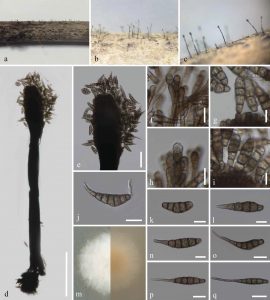Vamsapriya yunnana H.B. Jiang, Phookamsak & K.D. Hyde, in Jiang, Phookamsak, Bhat, Khan, Bahkali, Elgorban & Hyde, Phytotaxa 356(1): 64 (2018)
Index Fungorum number: IF 554232, Facesoffungi number: FoF 04085
Etymology – Named after the Province “Yunnan”, China, from where this fungus was collected.
Holotype – HKAS 101752
Saprobic on dead bamboo culms. Sexual morph: Undetermined. Asexual morph: Hyphomycetous. Mycelium immersed in the substrate, composed of septate, branched, brown hyphae. Conidiophores macronematous, synnematous, dark brown, cylindrical, septate, branched at the apex, smooth-walled. Synnemata 0.7–1.1 mm long, with apical fertile part 60–80 μm wide, middle part 40–55 μm wide, basal part 65–80 μm wide, superficial, solitary, scattered at random, erect, rigid, dark brown to black, composed of compactly arranged conidiophores. Conidiogenous cells 6.7–9.3 × 3.8–4.8 μm (x̅ = 8 × 4.3 μm, n = 20), monotretic, enteroblastic, integrated or discrete, cylindrical to subglobose, apically rounded, brown to dark brown, smooth-walled, Conidia 50–70 × 9–11 μm (x̅ = 61 × 10 μm, n = 20), fusiform, broad at middle, straight to curved, brown, obtuse at base, rostrate at tip, septate, smooth-walled; body part 30–38 × 8–10 μm (x̅ = 35 × 9 μm, n = 20), initially 1–3-septate, up to 4–5-septate at maturity; apical rostrate part 15–30 μm long, 0–3-septate.
Culture characteristics – Conidia germinating on PDA within 24 hours at 20–25ºC, with germ tubes produced from one end. Colonies on PDA fast-growing, reaching 5 cm after one month at 20–25ºC; white, circular, after one week, cottony and pinkish after one month. Mycelium superficial to immersed in media, with dark brown, branched, septate, smooth hyphae.
Material examined – China, Yunnan Province, Honghe Prefecture, Pingbian County, near Tuanpo Reservoir, on dead bamboo culms, 20 September 2017, HB. Jiang, Pb006 (HKAS 101752, holotype!); ibid. (MFLU 17–1554, isotype!), ex-type living culture, MFLUCC 18–0468, KUMCC 18–0008.
Notes – Vamsapriya yunnana is similar to V. khunkonensis (Dai et al. 2014) in having brown to dark brown, up to 5-septate conidia at maturity. Vamsapriya yunnana has 0–3-septate conidia with a 15–30 μm long apical appendagelike and wider apical fertile region (V. yunnana: 60–80 μm vs. 20–35 μm: V. khunkonensis). In addition, V. yunnana forms a distinct lineage, separated from V. khunkonensis in a phylogram of Vamsapriya species with strong support. Therefore, V. yunnana is introduced as a novel species.

Fig 1. Vamsapriya yunnana (HKAS 101752, holotype). a–c Synnemata on bamboo surface. d Synnema. e Apex of synnema. f–i Conidiogenous cells with attached conidia. j Germinating conidium. k, l, n–q Conidia. m Culture characteristics on PDA after two weeks (frontage and back). Scale bars: d = 200 μm; e = 50 μm; q = 20 μm; j, o, p = 15 μm; f–i, k, l, n = 10 μm.
